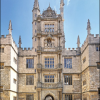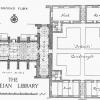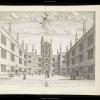III.1 The university curriculum
Image 1: The structure of established learning. From the late Middle Ages well into the seventeenth century, universities across Europe adopted a more or less uniform curriculum. This diagram lays out in graphic form the series of distinctions needed to understand the structure of established learning in this period.
Four faculties. The apex of the curriculum was formed by the 'three higher faculties': theology, law, and medicine. Everything below these was included in a fourth faculty, known as the ‘arts’ or ‘philosophy’ faculty. As this ambiguous nomenclature suggests, this fourth faculty was divided between the three philosophies and the seven liberal arts, which were further divided into the trivium and the quadrivium.
Three philosophies. Study of the 'three philosophies' was regarded as propaedeutic (that is, preparatory) to the study of the three higher disciplines. Natural philosophy or physics studied the natural world (governed by necessary laws and subject to change) and was necessary especially for the further study of medicine. Moral philosophy (consisting of ethics and politics, both of which depended on human volition) was preliminary especially to the study of law. Metaphysics (which studied changeless first principles) was closely related to theology.
Seven liberal arts. The seven liberal arts were, in turn, propaedeutic to the study of philosophy. These were divided into the trivium (the fundamental linguistic arts of grammar, rhetoric, and logic) and the quadrivium (the quantitative arts of arithmetic, geometry, music, and astronomy).
Liberal versus 'mechanical' learning. The entire university curriculum falls within the category of 'liberal' learning. In essence, this means that university learning was linguistic and cerebral, and did not involve manual work of any kind. This meant that the vast range of 'arts' involving manual labour were excluded from the university. This is a distinction of the utmost important for the following pair of lectures. Even the most disruptive developments within liberal learning -- such as Renaissance humanism and Reformation theology -- were readily absorbed within the established curriculum. Intellectual developments originating in the mechanical arts (i.e. within technologies for engaging directly with the material world) proved much more disruptive to the established curriculum leading to crises in the received world view not resolved within our period.
Image 2: The Schools Quadrangle, Oxford. Nowhere is this standard curriculum given more perfect architectural expression than in the Schools Quadrangle built between 1613 and 1624 as the centre of university teaching in Oxford. Within the quadrangle, every one of these disciplines is inscribed over a doorway to one of the ‘schools’ (as the chambers set aside for lectures and disputations in the named disciplines were called). The three higher faculties and the three philosophies all have ‘schools’ of their own. The quadrivium occupies three schools rather than four, because arithmetic and geometry are housed together. The trivium, on the other hand, occupies four schools rather than three, because separate housing is provided for Latin and Greek grammar. Only one discipline is listed which is not in this age-old scheme: history, which shares a school with grammar.
Images 4-7. See metadata for individual images.
Credits: Nermeen Hilton (third-year student, Balliol College, Oxford: Image 1) and Howard Hotson (February 2018)



